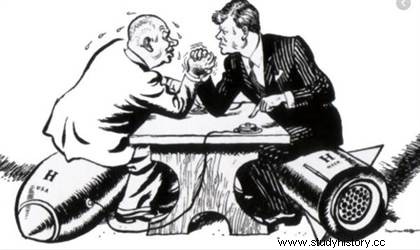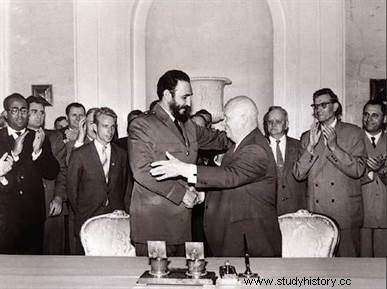 October 14, 1962 broke out the Cuban crisis , in the midst of the Cold War. The United States discovered missile launch pads provided by the Soviet Union on the island. US President John Fitzgerald Kennedy then announced a naval blockade of the island and ordered his fleet to intercept the Soviet ships carrying the rockets to Cuba. After several days of tense negotiations, during which a nuclear war seemed imminent, Soviet leader Nikita Khrushchev agreed to withdraw his missiles in exchange for Kennedy's promise not to invade Cuba.
October 14, 1962 broke out the Cuban crisis , in the midst of the Cold War. The United States discovered missile launch pads provided by the Soviet Union on the island. US President John Fitzgerald Kennedy then announced a naval blockade of the island and ordered his fleet to intercept the Soviet ships carrying the rockets to Cuba. After several days of tense negotiations, during which a nuclear war seemed imminent, Soviet leader Nikita Khrushchev agreed to withdraw his missiles in exchange for Kennedy's promise not to invade Cuba.
Why the Cuban crisis?
On January 1, 1959, insurgents led by Fidel Castro and Che Guevara overthrew pro-American dictator Battista. Relations between Havana and Washington deteriorated rapidly after the agrarian reform of June 1959, which prohibited properties of more than 40.5 ha, after the nationalization of sugar refineries (August 1959) and the nationalization of oil refineries (Oct , 1959). By the end of 1960, the value of US corporate assets confiscated by the new Cuban regime was approximately $1 billion. In retaliation, the United States severed diplomatic relations with Cuba and gave asylum and assistance to anti-Castro Cuban refugees (over 200,000 by 1961).
 In October 1960, Washington imposed a trade embargo on the island. On April 17, a commando of anti-Castro exiles supported and trained by the United States landed in the Bay of Pigs, in the south of the island. The failure of this invasion attempt accelerated the socialist orientation of the regime, which moved closer to the USSR, which became the main buyer of Cuban sugar.
In October 1960, Washington imposed a trade embargo on the island. On April 17, a commando of anti-Castro exiles supported and trained by the United States landed in the Bay of Pigs, in the south of the island. The failure of this invasion attempt accelerated the socialist orientation of the regime, which moved closer to the USSR, which became the main buyer of Cuban sugar.
The Cold War at its peak
In May 1960, Soviet leader Nikita Khrushchev pledged the protection of the Soviet Union to the revolutionary regime of Fidel Castro, newly installed in Cuba. After a trip to Moscow by Raul Castro, the brother of the new Cuban leader, in July 1962, the USSR quickly set up a plan to supply Cuba with medium and intermediate range missiles. The missiles are transported in the greatest secrecy in Russian ships transporting agricultural equipment to deceive the vigilance of the Americans. But on October 14, 1962, an American spy plane flying over Cuba discovered the current installations on the island.
 The existence of these missiles does not fundamentally alter the military balance between the two great powers, because American territory is already vulnerable to long-range missiles installed in the Soviet Union. However, the strength of the symbol (installing this type of weapon about 150 km from the coast of Florida) constitutes a provocation that the United States cannot leave unanswered on pain of seeing the credibility of its strike force called into question.
The existence of these missiles does not fundamentally alter the military balance between the two great powers, because American territory is already vulnerable to long-range missiles installed in the Soviet Union. However, the strength of the symbol (installing this type of weapon about 150 km from the coast of Florida) constitutes a provocation that the United States cannot leave unanswered on pain of seeing the credibility of its strike force called into question.
President Kennedy announced in October 1962 the establishment of a maritime blockade around Cuba in order to prevent the arrival of new Soviet missiles (officially, it was not is only a "quarantine"). Kennedy calls on the Soviet Union to dismantle and remove its weapons.
Krushchev's retreat
After several days of negotiations between Kennedy and Khrushchev, during which the world lived under the threat of a possible nuclear war, the Soviet leader agreed, on October 28, to dismantle the launch pads and bring the rockets back to the Soviet Union. He also offers the United States to inspect Cuban sites in exchange for the American guarantee not to invade the island.
The final agreement between the two heads of state includes a secret clause by which the United States undertakes to withdraw the missiles recently installed in Turkey. Aerial reconnaissance carried out by the United States over Cuba confirms the dismantling of the sites as of November 12 and the quarantine is lifted on November 20.
The consequences of the Cuban crisis
In the aftermath of the period of paroxysmal tension caused by the rocket crisis in October-November 1962, Fidel Castro draws up a propagandist and provocative assessment. Hiding the negative consequences of the crisis for the island, he places himself in a logic of victory, explaining how the iniquity of American policy has rallied many Cubans, hitherto skeptics, to the revolutionary cause. Implicitly addressing the American President, J. F. Kennedy, he affirms that the Revolution emerges greater and stronger from the test and the threat.
The psychological standoff to which this crisis in Cuba has given rise, by the magnitude of the dangers it reveals to the eyes of the world, finally leads to the beginning of relative relaxation in the arms race between the two superpowers. The first sign of partial disarmament was given on August 5, 1963 with the signing of an agreement which prohibited, even for peaceful purposes, nuclear tests at sea and in the atmosphere. In the process, a direct line of communication, the famous “red telephone”, was set up between the American and Soviet administrations to manage crisis situations in the future.
To go further
- 13 Days, The Cuban Missile Crisis, by Robert Kennedy. Plural, 2018.
- How Kennedy Avoided World War III, October 1962:Diary of the Missile Crisis, by Vincent Touze. André Versailles editions, 2012.
- Thirteen Days that shook the world, historical fiction by Roger Donaldson. Metropolitan Video, 2013.
